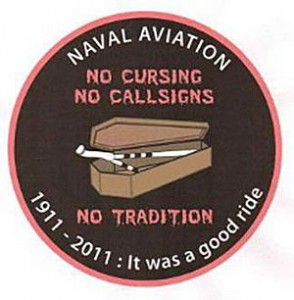
A patch floating around some Navy aviation units
Navy aviation is celebrating its 100 year anniversary this year, and there have been many celebrations throughout the aviation community. Women have been part of the naval aviation community since 1974. That’s 37 years, or more than a third of naval aviation’s history. They were restricted to so-called non-combat aircraft until 1993, but since there were so few of them, it meant men also flew such non-combat aircraft…were they any less a pilot than a woman?
Some in naval aviation think “tradition” was broken when women were finally able to become part of the navy’s aviation team. The military certainly broke tradition this week when it ended “Don’t Ask, Don’t Tell.” And odious traditions continue, like the unofficial aviation patch circulating among some Navy aviators that declares Navy aviation, after a glorious century, now has NO TRADITION (that’s a tailhook inside the coffin).
Some in the Navy blame women for this purported loss of tradition. For decades, women were such a small minority that they were highly visible and therefore subject to increased scrutiny. Many male compatriots did not know how to act around them; the women, being young and inexperienced, did not understand why their gender put them at odds with their squadron-mates. Over time the newness wore off, and women settled in. But it was not always smooth sailing.
On the civilian side, women became as interested in flying as men. By 1911 the first licensed woman aviator was Harriet Quimby, an American, who in 1912 made history by becoming the first woman to fly solo over the English Channel, in a plane she had never flown. Of her flight she said:
For the first time I was to fly a Bleriot monoplane. For the first time I was to fly by compass. For the first time I was to make a journey across the water. For the first time I was to fly on the other side of the Atlantic. My anxiety was to get off quickly.
That same day, another pilot, a man named D. Leslie Allan, an Englishman, took off from London to fly to Dublin, but he never made it, somehow lost in the Irish Sea. Such was the risk of flying in those early days.
And of course, in the 1920s and 1930s, many women went toe-to-toe with the men in setting records for first flights, including Amelia Earhart and Jackie Cochran. Cochran founded the Women Airforce Service Pilots (WASP), who, during World War II, flew every plane in the military inventory cross country and overseas. When women were finally able to join the military as permanent members in 1948, Cochran joined the Air Force Reserve where she eventually rose in rank to lieutenant colonel. Since then, women have actively participated in combat tours, most recently in Iraq, Afghanistan, and Libya. And women aviators are serving at some of the higher command levels of the aviation community. Yet, there is still resistance…
Now, according to the Washington Times, an unofficial patch is being circulated electronically among aviators as a protest against “political correctness taking over mixed-sex ready rooms [because] aviators have to watch everything they say for fear of facing a sexual-harassment complaint.” The ugly brown patch says, “No cursing. No call signs. No tradition.”
Of course, most of the male aviators currently in service have probably never been in anything but a mixed-gender ready room. But that’s not the point, is it? Apparently the point is that some of the boys don’t feel like they can act like goons, swear like the devil, harass women and homosexuals by assigning them demeaning call signs, and otherwise not act like officers and gentlemen. Because, gentle readers, all naval aviators are officers.
Tradition aside, everyone deserves to be treated with respect, regardless of gender, regardless of rank, regardless of sexuality. It’s obvious to me that until this type of underground, vicious slur blaming women is stopped, problems will continue to plague the military, its effectiveness, its morale, its readiness, and ultimately its mission. And when that happens, military tradition certainly will be dead.


